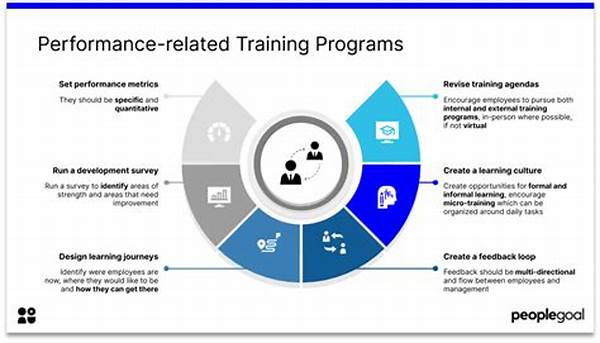Hey there! Have you ever wondered how some companies have such tight-knit teams while others struggle to keep everyone on the same page? Well, one not-so-secret ingredient to a harmonious workplace is employee relationship development programs. These initiatives aren’t just for show—they can transform the workplace by fostering better communication, trust, and collaboration among team members. Let’s dive into the world of these programs and see what they’re all about!
Read Now : “nature Immersion For Calmness”
Understanding Employee Relationship Development Programs
Alright, picture this: a workplace where employees genuinely support one another, share ideas freely, and collaborate effectively. Sounds dreamy, right? This is where employee relationship development programs come into play. These programs focus on building and nurturing the relationships among employees to create a positive and productive work environment.
Such programs can include team-building activities, mentorship opportunities, and communication workshops. The aim is not just to improve productivity but also to enhance employee satisfaction and retention. When people feel valued and connected, they’re more likely to stick around and contribute meaningfully. Moreover, these programs can turn classic “office politics” into constructive dialogue, bridging gaps between different departments and levels within the organization.
By investing in employee relationship development programs, companies are basically saying, “Hey, we care about your well-being and your growth!” It’s an investment in a positive workplace culture that pays off through higher morale, reduced turnover, and, ultimately, a stronger bottom line. So, next time you hear about such programs, remember that they play a crucial role in making the work world a better place.
The Benefits of Employee Relationship Development Programs
1. Increased Morale: Employee relationship development programs boost morale by fostering open communication and mutual respect among team members, making work more enjoyable.
2. Enhanced Teamwork: With activities that emphasize collaboration, these programs strengthen teamwork skills, ensuring projects run smoothly and efficiently.
3. Better Communication: Programs can break down barriers, encouraging open dialogue and preventing misunderstandings within the team.
4. Increased Retention: When employees feel connected and valued, they’re more likely to stay with the company, reducing turnover.
5. Boosted Productivity: Happy and engaged employees are more productive, and these programs help maintain that level of enthusiasm and commitment.
Implementing Employee Relationship Development Programs
Starting employee relationship development programs might sound a bit daunting, but it’s totally doable with the right approach. Begin by identifying the unique needs and challenges within your organization. Are there communication gaps? Is teamwork lagging? Understanding these aspects will help tailor a program that addresses specific areas for improvement.
Next up, involve your employees in the planning process. After all, they’re the heart and soul of the company. Gather their input and have open discussions about what they think could enhance team dynamics. This not only makes them feel valued but also ensures the programs are relevant and impactful. From monthly team-building activities to mentorship initiatives, the options are endless and should align with your organizational goals.
Finally, ensure continuous evaluation of these programs. The workplace is ever-evolving, and so should the initiatives. By regularly assessing the effectiveness of the employee relationship development programs, you can make necessary adjustments to keep them fresh and beneficial. Remember, the goal is to create a sustainable workplace environment that thrives on connection and collaboration.
Key Components of Successful Employee Relationship Development Programs
1. Tailored Activities: Successful programs are customized to meet the needs of the organization and its employees.
2. Active Participation: Engaging all employees encourages buy-in and maximizes the benefits of the program.
3. Ongoing Evaluation: Regular assessments ensure the program remains effective and aligned with company goals.
4. Open Communication: Encouraging honest dialogue helps address potential issues before they escalate.
Read Now : Romantic Beachfront Resorts In Bali
5. Inclusive Culture: Programs should celebrate diversity and promote inclusion to strengthen team cohesion.
6. Leadership Support: Endorsement from management is crucial for program success and employee participation.
7. Focus on Well-being: Prioritizing mental and emotional health enhances overall employee satisfaction.
8. Flexible Approach: Adaptability ensures the program evolves with the needs of the team and organization.
9. Clear Objectives: Defining the goals of the program helps measure success and maintain direction.
10. Celebrating Success: Recognizing achievements fosters a positive atmosphere and motivates further participation.
Best Practices for Launching Employee Relationship Development Programs
So, you’re sold on the idea of employee relationship development programs and ready to get the ball rolling. Awesome! Here are some best practices to consider. First up, set clear goals. Knowing what you want to achieve will guide the program’s focus and ensure every activity has a purpose. These goals should align with your company’s values and vision.
Next, communicate the benefits of the program to the entire team. Get everyone on board by explaining how it can positively impact their work life. This not only motivates participation but also reinforces the importance of collective growth. While you’re at it, offer opportunities for employees to contribute ideas and feedback. This involvement promotes a sense of ownership and increases the likelihood of program success.
Don’t forget to celebrate the small wins along the way! Recognize team achievements and individual contributions to make everyone feel appreciated. This positive reinforcement encourages ongoing engagement and shows employees that their efforts in participating matter. Finally, keep the program dynamic. As your team evolves, so should your initiatives. Regularly assess and tweak elements to keep them fresh and aligned with your team’s changing needs and aspirations.
Reflecting on Employee Relationship Development Programs
In conclusion, employee relationship development programs are a game-changer for fostering a collaborative and positive workplace environment. By enabling employees to connect, communicate, and grow together, these initiatives not only improve performance but also lead to a more engaging work experience. Whether you’re an employee or employer, understanding the value of these programs can unlock new levels of workplace satisfaction and efficiency.
For those looking to implement or improve existing programs, remember that customization and open communication are key. By actively involving employees and aligning the programs with organizational goals, the resulting benefits can be tremendous—from increased morale and reduced turnover to improved productivity. Employee relationship development programs are more than just corporate jargon; they’re essential tools for building strong, resilient, and harmonious workplace relationships.
So, if you’re contemplating whether these programs are worth the effort, think of the tremendous impact they can have on both individual and organizational growth. They’re a testament to the idea that when employees thrive together, so does the company. Thus, investing in employee relationship development programs is a win-win scenario for everyone involved, making work not just a place to be, but a place to belong.



